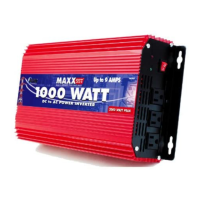
Do you have a question about the Vector MAXX SST VEC049C and is the answer not in the manual?
| Output Voltage | 120V AC |
|---|---|
| Frequency | 60 Hz |
| Efficiency | Up to 90% |
| Waveform | Modified Sine Wave |
| Cooling | Fan Cooled |
| Protection Features | Overload, Short Circuit |
| Input Voltage | 12V DC |
Lists warnings to reduce the risk of fire, electric shock, explosion, or personal injury.
Lists cautions regarding user-serviceable components, installation locations, and electrical system compatibility.
Discusses power loss from inadequate cables and proper installation for secure electrical connections.
Describes front panel items like outlets, LEDs, and the on/off switch, and back panel connectors.
Lists built-in safety features like overload, over-temperature, short-circuit, and voltage shutdowns.
Warns against charging certain batteries and using specific appliances like flashlights or cordless tool chargers.
Explains how inverters can function as UPS, providing continuous AC power during outages.
Covers determining appliance wattage, power output limits, input voltage ranges, and startup surge requirements for safe operation.
Provides steps to determine minimum battery size needed, including calculating wattage and estimating usage hours.
Explains factors affecting operating time and references curves for load vs. battery capacity.
Details the low battery alarm, shutdown conditions, and electronic circuit protection against overload/short circuits.
Specifies required DC input voltage, amperage, and DC power sources like batteries or vehicles.
Details safe locations, temperature ranges, clearance requirements, and environmental factors for inverter placement.
Outlines the steps for wiring the inverter to a DC power source, emphasizing correct polarity.
Details the procedure for testing the inverter with a temporary setup and basic tools.
Details preparation steps, required parts, and step-by-step procedures for permanent inverter installation and secure wiring.
Discusses common issues like power tools not starting, buzzing in audio, or inverter shutdown due to overload.
Provides a table of common problems, their possible causes, and suggested remedies for inverter issues.
